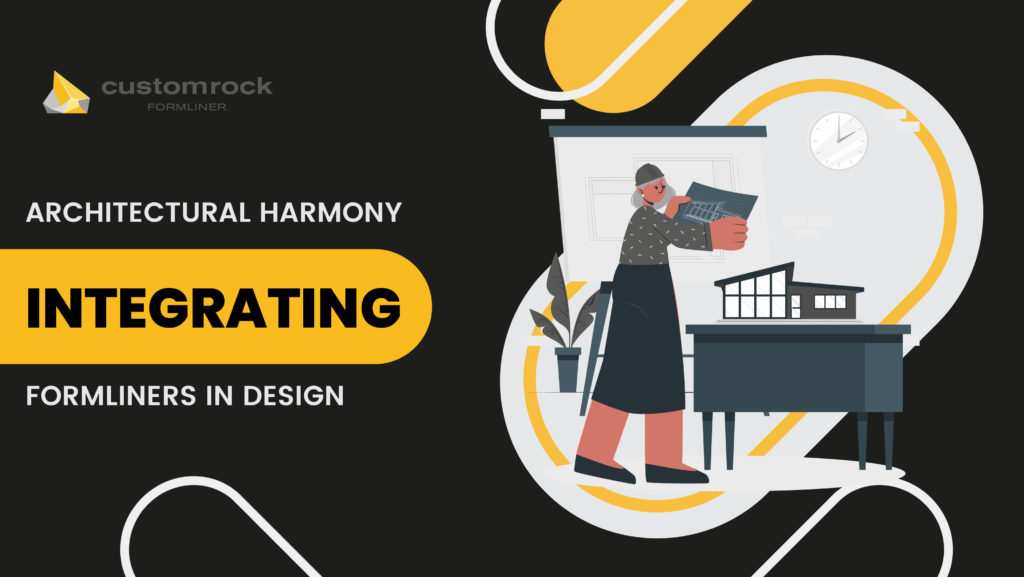TL; DR
Formliners are a versatile tool in architecture that allows designers to add unique textures and patterns to concrete and other materials. They create a balance between aesthetics and functionality. Formliners tremendously help designers and architects to enhance visual appeal of architectural projects.
Formliners also provide practical benefits like insulation and safety. Successful integration of formliners in design requires some steps such as collaboration with designers, thoughtful selection, and proper installation.
Sustainability and budget should also be considered when integrating formliners in design. Moreover, customization options of formliners transform ordinary surfaces into aesthetic buildings. More importantly, they also empower architects to create harmonious and distinctive design integration.
Achieving Architectural Harmony
In the world of architecture, achieving architectural harmony is an essential factor. The ability to seamlessly blend aesthetics and functionality is necessary to get exceptional designs. Using formliners is the one of the prominent techniques to achieve this feat.
Formliners are known as multi-purpose tools in the world of architecture. Architects and designers can shape surfaces and infuse them with texture, pattern, and character, with their help. Successful design integration can turn any ordinary surface into remarkable architecture.

Formliners: The Art of Sculpting Surfaces
Formliners are a means to create unique textures and designs on concrete surfaces. By introducing formliners into the design process, architects can make any structure stand out from the rest.
Whether it’s a building facade, interior wall, or landscape feature, formliners work as a canvas for creativity. Formliners usually come in an array of material; from flexible rubber and polyurethane to more rigid materials like fiberglass.
This diversity allows the creation of unique designs. The design integration can vary from simple patterns to bold geometric patterns. Whether using nature as inspiration or modern technical designs, formliners give architects the freedom to explore different possibilities.
Harmony in Practice: Balancing Aesthetics and Functionality
The charm of architectural harmony is in the balance between aesthetics and functionality. Formliners are best at maintaining this balance by offering aspects such as:
1. Visual Appeal:
Formliners enable architects to add depth, dimension, and texture to surfaces which results in a captivating design. The balance of light and shadow across textured surfaces creates a dynamic visual experience. This visual appeal turns buildings and spaces into living artwork that changes with the shifting of sunlight.
2. Practical Utility:
Beyond aesthetics, formliners can enhance the functionality and durability of structures. For example, the use of textured formliners on exterior walls can provide increased insulation, reduce the impact of weathering, and offer structural support.
Moreover, formliners can be used to improve safety as they offer slip-resistant surfaces in high foot traffic areas.
Best Practices for Formliner Integration
Formliners are an essential tool for architects and designers seeking to create visually appealing and unique concrete surfaces. These versatile materials offer a wide range of design possibilities that help architects to integrate various textures.
Successful formliner integration requires careful planning and attention to detail to achieve architectural harmony. Here are some key considerations and best practices for integrating formliners seamlessly into architectural designs.
1. Understanding Formliners:
Before diving into design integration, it’s necessary to have know-how of what formliners are and the scope of their possibilities. Formliners are reusable molds that are made from various materials like elastomeric urethane, polyurethane, and fiberglass.
They are placed on ordinary surfaces, and then concrete is poured into them to create a design on the finished surface. These formliners can create an array of textures, including wood grain, stone, brick, and custom designs.
Understanding the characteristics of different types of formliners is helpful in choosing the right one for the project.
2. Early Collaboration:
Effective design integration of formliners begins with early collaboration among the architect, contractor, and the manufacturer. By including the formliner manufacturer in the initial design, architects can gain valuable insights and technical expertise.
They can help select the best option, recommend suitable formwork, and educate architects about potential downsides. This early collaboration leads to an efficient and successful integration process.
3. Aligning Formliner Selection with Design Intent:
Architectural designs have unique concepts and design intent that are considered the foundation of the project’s appearance. When integrating formliners, it’s important to select patterns and textures that align with the overall design vision.
Formliners should align with the building’s style and offer the intended aesthetic appeal. Whether it’s a modern, industrial, or natural theme, choosing the right formliners will contribute to achieving architectural harmony.
4. Suitability for Formwork:
Formliners should be compatible with the chosen formwork system. This includes considering the size, shape, and complexity of the design. Certain formliners may require extensive formwork modifications, while others may seamlessly adapt to the formwork.
A balance between design integration and practical feasibility is crucial to avoid complications in the construction phase.
5. Customization Possibilities:
Formliners offer opportunities for customization that allow architects to create unique designs that are modified according to the project. Custom formliners can include complex logos, patterns, or specific textures that relate directly to the building’s purpose and its location. While pre-made formliners offer convenience, customized options can elevate the project’s uniqueness and make it stand out.
6. Sustainability and Maintenance:
Using sustainable design practices is essential in modern architecture. Architects usually consider eco-friendly formliner materials to minimize environmental impact. Additionally, they prioritize ease of maintenance when selecting formliners.
They also ensure that the chosen textures and patterns are not only visually appealing but also practical to maintain over time.
7. Proper Installation and Quality Control:
The success of design integration with formliners largely depends on proper installation. It’s essential to follow the manufacturer’s guidelines and ensure the formliners are securely attached to the formwork. Regular quality control checks during the installation process can help identify and sort out any issues timely.
8. Safety and Accessibility:
Architects must consider the safety and accessibility aspects of formliner integration. They should avoid using formliners in areas that may become slippery when wet or have any tripping hazards.
By placing safety as a priority, the design will be user-friendly and cooperative with accessibility regulations.
9. Budget and Time Constraints:
Including formliners in design integration may involve additional costs compared to traditional concrete designs. Correctly budgeting and scheduling the design integration process will ensure that the project stays on track and meets its deadlines.
10. Post-Construction Assessment:
After project completion, architects should evaluate the formliner integration to identify successes and areas for improvement.
This post-construction assessment can be useful in improving future projects. It will also enhance the effectiveness of formliner integration in future designs.







